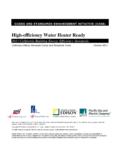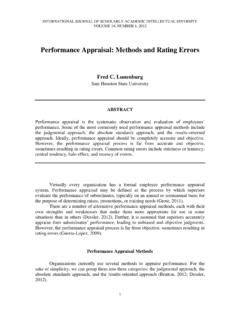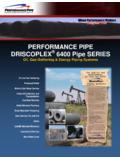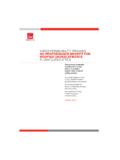Transcription of Connecticut Builidng Standard Guidelines …
1 Connecticut building Standard Guidelines compliance manual for high performance Buildings September 2011 . Prepared For The Connecticut Office of Policy and Management by: 91 Hartwell Avenue Lexington, MA 02421. With Technical Support provided by 120 Water Street, Suite 350. North Andover, MA 01845. Connecticut compliance manual for high performance Buildings This publication was commissioned and finalized by the Connecticut Office of Policy and Management, in consultation with the Department of Public Works, the Department of Public Safety, the Department of Environmental Protection, and the Institute for Sustainable Energy at Eastern Connecticut State University.
2 It is designed to provide accurate and authoritative information with regard to the subject matter covered. However, although great care has been taken in the compilation and publication of this manual , it is published with the understanding that (1) the publisher and authors make no guarantee that the manual meets all federal, state, and local statutory, regulatory, or other requirements, and (2) the publisher and authors are not engaged in rendering professional advice via this manual or their work and/or affiliation with the State of Connecticut .
3 The publisher and authors cannot be responsible for errors or omissions or any agency's interpretations, applications, and changes of regulations or specifications described in this publication. Use of any provision contained herein is the sole responsibility of the specifier and project owner. The authors wish to acknowledge the support of the Kendall Foundation and the Connecticut Green building Council for support in advancing the development of this manual . Published by: Northeast Energy Efficiency Partnerships, Inc. 91 Hartwell Avenue Lexington, Massachusetts 02421.
4 And Energy & Resource Solutions 120 Water Street, Suite 350. North Andover, MA 01845-2648. February 2011 Summary of changes: Additional compliance strategies are provided for optional measure 16a-38k-6(b)(11). June 2011 Summary of changes: Allows for the use of Appendix G to determine energy modeling above code in mandatory requirement 16a-38k-3(c). September 2011 Summary of changes: 16a-38k-5(b) eliminated reference to walk-off systems for entryways, currently covered in 16a-38k-6(b)13; expanded compliance options under the following sections: Sections 16a-38k-4(b)4, 4(b)5.
5 And 4(b)7; Section 16a-38k-5(d), and Section 16a-38k-6(b)(4). This material is based upon work supported by the U. S. Department of Energy under grant award # DE-FG41-06R130172. ii Connecticut compliance manual for high performance Buildings Contents Introduction .. iv Regulation .. v Mandatory Requirements All Buildings building Commissioning ..1. Integrated Design Process .. 6. Energy performance ..9. Energy Star Specification .. 11. Indoor Air Quality Management Plan .. 13. Water Usage ..15. Recyclable Materials .. 17. Erosion and Sedimentation Control.
6 18. No Smoking ..20. Integrated Pest Management 21. Chlorofluorocarbon (CFC) Based Refrigerant ..23. Minimum Ventilation Requirements ..25. building Standard Optional Strategies State Facilities Energy Efficiency and Renewable Energy ..26. Indoor Environment ..31. Water Efficiency . 36. Recycling, Reuse, and Sustainability ..38. Site Selection and Development . 41. Operations and Procedures/Innovation 48. Mandatory Requirements Schools Acoustical standards ..50. Properly Locate Outside Air Intakes ..51. Install Gas Equipment with Electronic Ignition.
7 52. Use Low VOC Materials 53. Environmental Assessment of building Site 54. HEPA Vacuuming ..56. building Standard Optional Strategies Schools Energy Efficiency and Renewable Energy ..57. Indoor Environment ..62. Water Efficiency .. 67. Recycling, Reuse, and Sustainability ..69. Site Selection and Development . 72. Operations and Procedures/Innovation .. 78. Regulation compliance Alternative for building Standard Options .80. compliance Checklist-State Facilities ..82. compliance Checklist-Schools .. 85. high performance Buildings Glossary ..88. iii Connecticut compliance manual for high performance Buildings Introduction This handbook has been developed to assist state and local building code officials, architects, and contractors in complying with State of Connecticut Regulation Section 16a-38k-1 through 9: The Establishment of high performance building Construction standards for State-Funded Buildings.
8 It contains Guidelines and requirements for meeting both mandatory and optional strategies to ensure compliance with the regulation. This handbook was prepared to allow periodic updates as referenced materials are modified and updated. These regulations were developed by the Connecticut Office of Policy and Management in consultation with the Department of Public Works, the Department of Environmental Protection, the Department of Public Safety, and the Institute for Sustainable Energy at Eastern Connecticut State University. The regulation sets environmental and energy efficiency standards for state-funded facilities that are newly constructed or are undergoing major renovations.
9 For state agency buildings, this regulation includes twelve mandatory requirements that must be met by all projects. In addition, there are sixty optional strategies, twenty-six of which must be met in order for the project to be in compliance . For schools, the regulation requires buildings to meet the twelve mandatory requirements that state agency buildings must meet plus six additional mandatory measures. Schools then must meet twenty-eight of fifty-nine optional strategies. The regulations were adopted primarily to require state-funded buildings to be built utilizing a high performance building Standard equivalent to that of the United States Green Buildings Council (USGBC) Leadership in Energy and Environment Design (LEED) Green building Rating System -Silver.
10 This rating system primarily focuses on five areas of concern: sustainable site development, water savings, energy efficiency, materials selection, and indoor environmental quality. Complying with these regulations will produce buildings that consume less energy, conserve natural resources, are more comfortable, healthier, and are easier and less costly to maintain. Disclaimer: This report was prepared in part as an account of work sponsored by an agency of the United States Government. Neither the United States Government nor any agency thereof, nor any of their employees, makes any warranty, express or implied, or assumes any legal liability or responsibility for the accuracy, completeness, or usefulness of any information, apparatus, product, or process disclosed, or represents that its use would not infringe privately owned rights.















